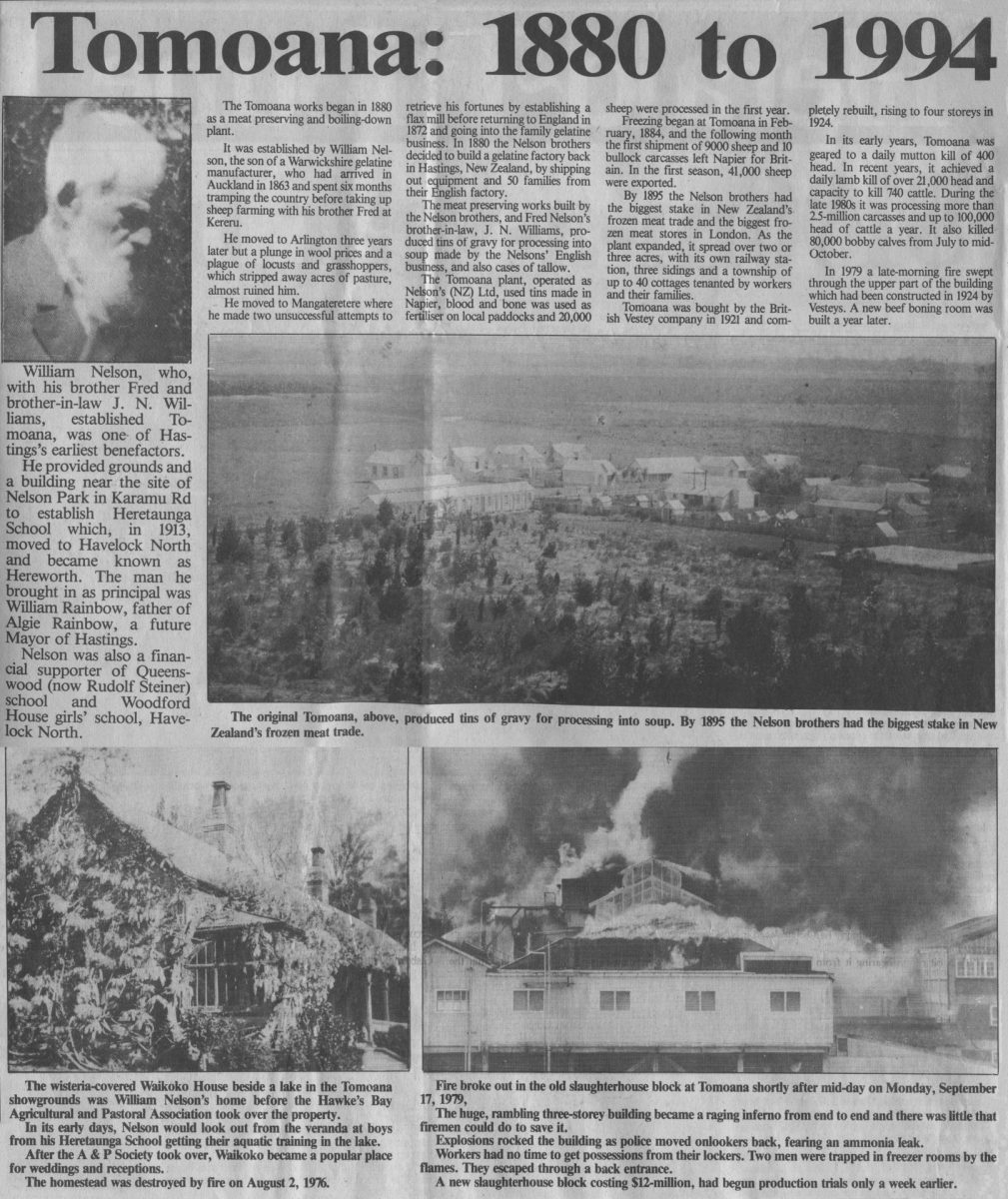Tomoana: 1880 to 1994
The Tomoana works began in 1880 as a meat preserving and boiling-down plant.
It was established by William Nelson, the son of a Warwickshire gelatine manufacturer, who had arrived in Auckland in 1863 and spent six months tramping the country before taking up sheep farming with his brother Fred at Kereru.
He moved to Arlington three years later but a plunge in wool prices and a plague of locusts and grasshoppers, which stripped away acres of pasture, almost ruined him.
He moved to Mangateretere where he made two unsuccessful attempts to retrieve his fortunes by establishing a flax mill before returning to England in 1872 and going into the family gelatine business. In 1880 the Nelson brothers decided to build a gelatine factory back in Hastings, New Zealand, by shipping out equipment and 50 families from their English factory.
The meat preserving works built by the Nelson brothers, and Fred Nelson’s brother-in-law, J. N. Williams, produced tins of gravy for processing into soup made by the Nelsons’ English business, and also cases of tallow.
The Tomoana plant, operated as Nelson’s (NZ) Ltd, used tins made in Napier, blood and bone was used as fertiliser on local paddocks and 20,000 sheep were processed in the first year.
Freezing began at Tomoana in February, 1884, and the following month the first shipment of 9000 sheep and 10 bullock carcasses left Napier for Britain. In the first season, 41,000 sheep were exported.
By 1895 the Nelson brothers had the biggest stake in New Zealand’s frozen meat trade and the biggest frozen meat stores in London. As the plant expanded, it spread over two or three acres, with its own railway station, three sidings and a township of up to 40 cottages tenanted by workers and their families.
Tomoana was bought by the British Vestey company in 1921 and completely rebuilt, rising to four storeys in 1924.
In its early years, Tomoana was geared to a daily mutton kill of 400 head. In recent years, it achieved a daily lamb kill of over 21,000 head and capacity to kill 740 cattle. During the late 1980s it was processing more than 2.5-million carcasses and up to 100,000 head of cattle a year. It also killed 80,000 bobby calves from July to mid-October.
In 1979 a late-morning fire swept through the upper part of the building which had been constructed in 1924 by Vesteys. A new beef boning room was built a year later.
William Nelson, who, with his brother Fred and brother-in-law J. N. Williams established Tomoana, was one of Hastings’s earliest benefactors.
He provided grounds and a building near the site of Nelson Park in Karamu Rd to establish Heretaunga School which, in 1913, moved to Havelock North and became known as Hereworth. The man he brought in as principal was William Rainbow, father of Algie Rainbow, a future Mayor of Hastings.
Nelson was also a financial supporter of Queenswood (now Rudolf Steiner) school and Woodford House girls’ school, Havelock North.
Photo captions –
The original Tomoana, above, produced tins of gravy for processing into soup. By 1895 the Nelson brothers had the biggest stake in New Zealand’s frozen meat trade.
The wisteria-covered Waikoko House beside a lake in the Tomoana Showgrounds was William Nelson’s home before the Hawke’s Bay Agricultural and Pastoral Association took over the property.
In its early days, Nelson would look out from the veranda at boys from his Heretaunga School getting their aquatic training in the lake.
After the A & P Society took over, Waikoko became a popular place for weddings and receptions.
The homestead was destroyed by fire on August 2, 1976.
Fire broke out in the old slaughterhouse block at Tomoana shortly after midday on Monday, September 17, 1979.
The huge, rambling three-storey building became a raging inferno from end to end and there was little that firemen could do to save it.
Explosions rocked the building as police moved onlookers back, fearing an ammonia leak.
Workers had no time to get possessions from their lockers. Two men were trapped in freezer rooms by the flames. They escaped through a back entrance.
A new slaughterhouse block costing $12-million, had begun production trials only a week earlier.












Do you know something about this record?
Please note we cannot verify the accuracy of any information posted by the community.